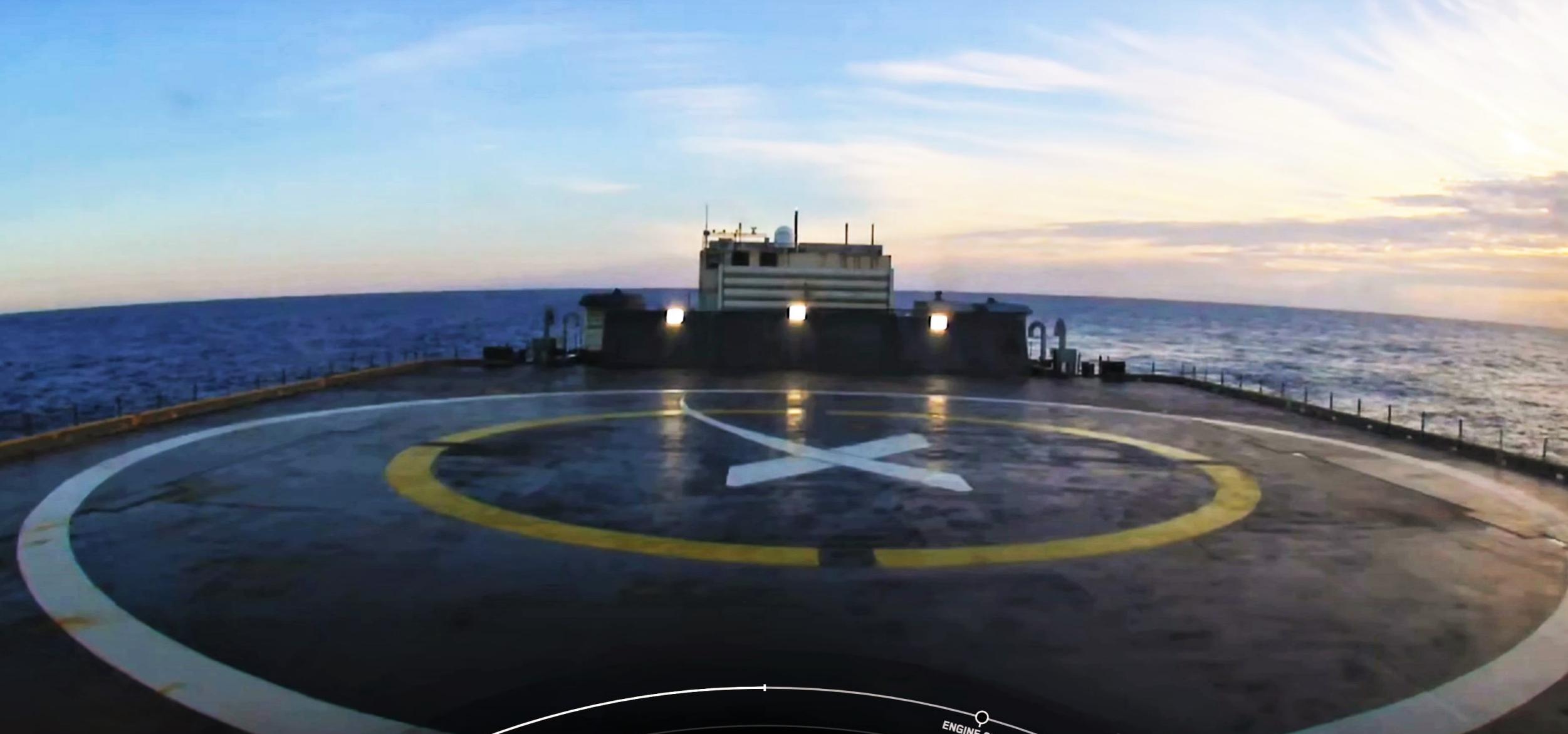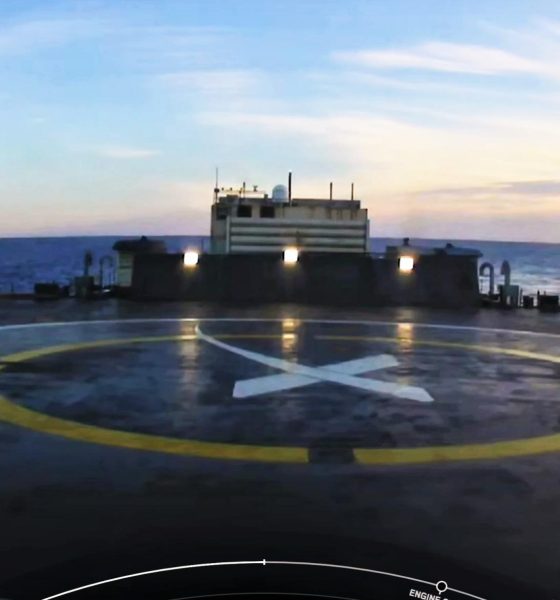

News
SpaceX rapidly turns around drone ship for sixth launch this month
SpaceX has rapidly turned around one of its two East Coast ‘autonomous spaceport drone ships’ and sent the vessel back to sea to support the sixth and final Falcon 9 launch planned this month.
SpaceX began the month with the successful launch of Transporter-4 – its fourth dedicated smallsat rideshare mission – on April 1st. Axiom-1 – the first all-private astronaut launch to the International Space Station – followed on April 8th. On the West Coast, another Falcon 9 rocket launched SpaceX’s second National Reconnaissance Office (NRO) spy satellite mission in two months on April 17th. Most recently, Falcon 9 booster B1060 tied SpaceX’s current 12-flight reusability record with the successful launch of a batch of Starlink satellites at 1:51 pm EDT on April 21st.
Drone ship Just Read The Instructions (JRTI) was tasked with supporting Falcon 9 booster recovery for Transporter-4 and Starlink 4-14. Now, less than a day after returning to Port Canaveral with booster B1060, the ship has been towed back to sea to support another Starlink launch and landing.
Due to almost two weeks of launch delays caused by Dragon recovery challenges, drone ship A Shortfall Of Gravitas (ASOG) – the second of two East Coast drone ships – has been stuck at sea while waiting to support NASA and SpaceX’s upcoming Crew-4 astronaut launch. To preserve plans for a late-April Starlink mission, SpaceX’s recovery team has needed to move about as fast as they ever have to allow JRTI to take ASOG’s place.
Following Starlink 4-14’s April 21st launch and landing, drone ship JRTI sailed into Port Canaveral around 2am EDT, April 24th. Within minutes of arriving at its usual berth, a dockside crane had swung over and begun installing a lifting cap on top of booster B1060. Less than four hours later, the booster was lifted off of JRTI’s deck and moved onto dry land, freeing up the space it occupied for any necessary inspections or repairs. The quick booster removal also gave SpaceX time to drive the drone ship’s robotic ‘Octagrabber’ recovery robot into a garage on its deck.
Just after 8pm EDT, less than 16 hours after JRTI reached its berth, support ship Bob towed the converted barge back out to sea. If Starlink 4-16 launches on time on April 29th, Just Read The Instructions will narrowly beat a three-year-old drone ship turnaround record (8d 6h) set by Of Course I Still Love You (OCISLY) in early 2019; recovering Falcon 9 booster B1062 just 8 days, 3 hours, and 42 minutes after Falcon 9 B1060 – and despite traveling ~1950 km instead of ~1850 km.
Ultimately, that distance is the main reason the current record has survived for so long. Short of building or modifying a new kind of recovery ship with a different type of hull, a flat-bottomed barge – towed or self-propelled – will never be able to traverse hundreds of miles of open ocean at high speeds.
Aside from breaking a potential drone ship turnaround record, Next Spaceflight reports that Starlink 4-16 will also almost certainly beat SpaceX’s current Falcon 9 booster turnaround record. Falcon 9 booster B1062 last launched Axiom-1 at 11:17 am EDT on April 8th. A 5:33 pm EDT, April 29th launch would translate to a turnaround time of 21 days and 6 hours, beating the current record of 27 days and 4 hours – set by B1060 in early 2021 – by more than a quarter.
If Crew-4 launches roughly on time, Starlink 4-14 will be SpaceX’s sixth launch in four weeks and 17th launch of 2022. If the company can sustain that pace over the remaining two-thirds of the year, it could feasibly launch more than 51 times in 2022.

Elon Musk
Elon Musk and Tesla AI Director share insights after empty driver seat Robotaxi rides
The executives’ unoccupied tests hint at the rapid progress of Tesla’s unsupervised Robotaxi efforts.

Tesla CEO Elon Musk and AI Director Ashok Elluswamy celebrated Christmas Eve by sharing personal experiences with Robotaxi vehicles that had no safety monitor or occupant in the driver’s seat. Musk described the system’s “perfect driving” around Austin, while Elluswamy posted video from the back seat, calling it “an amazing experience.”
The executives’ unoccupied tests hint at the rapid progress of Tesla’s unsupervised Robotaxi efforts.
Elon and Ashok’s firsthand Robotaxi insights
Prior to Musk and the Tesla AI Director’s posts, sightings of unmanned Teslas navigating public roads were widely shared on social media. One such vehicle was spotted in Austin, Texas, which Elon Musk acknowleged by stating that “Testing is underway with no occupants in the car.”
Based on his Christmas Eve post, Musk seemed to have tested an unmanned Tesla himself. “A Tesla with no safety monitor in the car and me sitting in the passenger seat took me all around Austin on Sunday with perfect driving,” Musk wrote in his post.
Elluswamy responded with a 2-minute video showing himself in the rear of an unmanned Tesla. The video featured the vehicle’s empty front seats, as well as its smooth handling through real-world traffic. He captioned his video with the words, “It’s an amazing experience!”
Towards Unsupervised operations
During an xAI Hackathon earlier this month, Elon Musk mentioned that Tesla owed be removing Safety Monitors from its Robotaxis in Austin in just three weeks. “Unsupervised is pretty much solved at this point. So there will be Tesla Robotaxis operating in Austin with no one in them. Not even anyone in the passenger seat in about three weeks,” he said. Musk echoed similar estimates at the 2025 Annual Shareholder Meeting and the Q3 2025 earnings call.
Considering the insights that were posted Musk and Elluswamy, it does appear that Tesla is working hard towards operating its Robotaxis with no safety monitors. This is quite impressive considering that the service was launched just earlier this year.
Elon Musk
Starlink passes 9 million active customers just weeks after hitting 8 million
The milestone highlights the accelerating growth of Starlink, which has now been adding over 20,000 new users per day.

SpaceX’s Starlink satellite internet service has continued its rapid global expansion, surpassing 9 million active customers just weeks after crossing the 8 million mark.
The milestone highlights the accelerating growth of Starlink, which has now been adding over 20,000 new users per day.
9 million customers
In a post on X, SpaceX stated that Starlink now serves over 9 million active users across 155 countries, territories, and markets. The company reached 8 million customers in early November, meaning it added roughly 1 million subscribers in under seven weeks, or about 21,275 new users on average per day.
“Starlink is connecting more than 9M active customers with high-speed internet across 155 countries, territories, and many other markets,” Starlink wrote in a post on its official X account. SpaceX President Gwynne Shotwell also celebrated the milestone on X. “A huge thank you to all of our customers and congrats to the Starlink team for such an incredible product,” she wrote.
That growth rate reflects both rising demand for broadband in underserved regions and Starlink’s expanding satellite constellation, which now includes more than 9,000 low-Earth-orbit satellites designed to deliver high-speed, low-latency internet worldwide.
Starlink’s momentum
Starlink’s momentum has been building up. SpaceX reported 4.6 million Starlink customers in December 2024, followed by 7 million by August 2025, and 8 million customers in November. Independent data also suggests Starlink usage is rising sharply, with Cloudflare reporting that global web traffic from Starlink users more than doubled in 2025, as noted in an Insider report.
Starlink’s momentum is increasingly tied to SpaceX’s broader financial outlook. Elon Musk has said the satellite network is “by far” the company’s largest revenue driver, and reports suggest SpaceX may be positioning itself for an initial public offering as soon as next year, with valuations estimated as high as $1.5 trillion. Musk has also suggested in the past that Starlink could have its own IPO in the future.
News
NVIDIA Director of Robotics: Tesla FSD v14 is the first AI to pass the “Physical Turing Test”
After testing FSD v14, Fan stated that his experience with FSD felt magical at first, but it soon started to feel like a routine.

NVIDIA Director of Robotics Jim Fan has praised Tesla’s Full Self-Driving (Supervised) v14 as the first AI to pass what he described as a “Physical Turing Test.”
After testing FSD v14, Fan stated that his experience with FSD felt magical at first, but it soon started to feel like a routine. And just like smartphones today, removing it now would “actively hurt.”
Jim Fan’s hands-on FSD v14 impressions
Fan, a leading researcher in embodied AI who is currently solving Physical AI at NVIDIA and spearheading the company’s Project GR00T initiative, noted that he actually was late to the Tesla game. He was, however, one of the first to try out FSD v14.
“I was very late to own a Tesla but among the earliest to try out FSD v14. It’s perhaps the first time I experience an AI that passes the Physical Turing Test: after a long day at work, you press a button, lay back, and couldn’t tell if a neural net or a human drove you home,” Fan wrote in a post on X.
Fan added: “Despite knowing exactly how robot learning works, I still find it magical watching the steering wheel turn by itself. First it feels surreal, next it becomes routine. Then, like the smartphone, taking it away actively hurts. This is how humanity gets rewired and glued to god-like technologies.”
The Physical Turing Test
The original Turing Test was conceived by Alan Turing in 1950, and it was aimed at determining if a machine could exhibit behavior that is equivalent to or indistinguishable from a human. By focusing on text-based conversations, the original Turing Test set a high bar for natural language processing and machine learning.
This test has been passed by today’s large language models. However, the capability to converse in a humanlike manner is a completely different challenge from performing real-world problem-solving or physical interactions. Thus, Fan introduced the Physical Turing Test, which challenges AI systems to demonstrate intelligence through physical actions.
Based on Fan’s comments, Tesla has demonstrated these intelligent physical actions with FSD v14. Elon Musk agreed with the NVIDIA executive, stating in a post on X that with FSD v14, “you can sense the sentience maturing.” Musk also praised Tesla AI, calling it the best “real-world AI” today.








